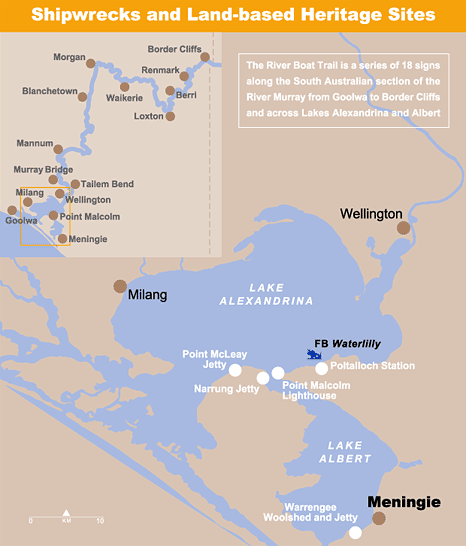
Meningie was set up as a small outstation on Lake Albert
 Meningie
Meningie
Meningie developed as a service centre for the surrounding pastoral properties. It was also a staging post on the main route to Melbourne, which included a steamer trip across the lakes.
The settlement began as an outstation of the South Australian Company, which took up a country around Lake Albert for sheep and cattle in 1843. The head-station was at Bonney Well, with outstations near Point Malcolm and at Warrengee. These isolated stations and other lakeside holdings depended on sailing and steam vessels for transportation and communication.
The town of Meningie was surveyed in 1866 and, within a year, two accommodation houses were established.
Cargo traffic across the Lakes increased as the town and surrounding properties prospered. Paddle steamers travelled between Milang and Meningie carrying passengers, mail and suppliers as well as the wool and other produce of the pastoral stations. By the early twentieth century the Jupiter, the Milang and the Murray steamed up to three times a week between the two ports, as well as to Narrung and other landing places on the Lakes.
PS Jupiter - the last regular trader on the Lakes
The Jupiter was originally built as an iron barge and shipped in sections from Scotland. It was assembled at Port Adelaide in 1866, with the intention of trading through the Murray Mouth. When this venture failed, an engine was installed and it was converted to a paddle steamer at Goolwa. For more than 30 years the Jupiter worked on the Murray and Darling Rivers transporting bales of wool, as well as carrying passengers, shearers and sheep.
In 1903 the Jupiter became the ail steamer on Lakes Alexandrina and Albert, trading across the waterways between Milang, Narrung and Meningie. The steamer's last visited to Meningie was in March 1914, but it continued to trade to other landings for a few years and in 1923 was altered in the hope of establishing an excursion trade. In 1930, when the vessel was laid up at the Milang wharf, it was the last regular trader on the Lakes.
A Crayfish Depot
In 1933 the Jupiter was taken to Port Adelaide and converted into a crayfish storage facility, believed to be the first floating fish depot in Australia. The funnels, engines and paddles were removed and wells were built into the engine room. Thousands of slots were cut into the hull so that sea water could wash through the compartments.
Fishing cutters stored excess crayfish or unusual marine specimens for the Glenelg Aquarium. This venture lasted only a few years and the Jupiter was eventually abandoned near Port Adelaide in the 1940s.

GPS: Zone 54 E 0349684 N 6049610
Panel near the toilet block in the Lions’ Park overlooking Lake Albert
Interpretive panels are located at:
River Boat Trail | Border Cliffs | Renmark | Berri | Loxton | Waikerie | Morgan | Blanchetown | Mannum
Murray Bridge | Tailem Bend | Wellington | Meningie | Point Malcolm | Milang | Goolwa
Please do not interfere in any way with ship-wrecks and land based heritage sites
Published with permission of Government of South Australia
Department for Environment and Heritage
Tell your friends you found this at murrayriver.com.au!
Copyright Discover Murray 2026. This site or any portion of this site must not be reproduced, duplicated, copied, sold, resold, or otherwise exploited for any commercial purpose that is not expressly permitted by DISCOVER MURRAY.






 Amy Shark The Solo Acoustic "Songs & Stories" Tour
Amy Shark The Solo Acoustic "Songs & Stories" Tour Lee Kernaghan Boys From The Bush The Concert
Lee Kernaghan Boys From The Bush The Concert The Australian Beach Boys Show
The Australian Beach Boys Show Kevin Bloody Wilson Aussie Icon Tour with special guest Jenny Talia
Kevin Bloody Wilson Aussie Icon Tour with special guest Jenny Talia Little By Little
Little By Little